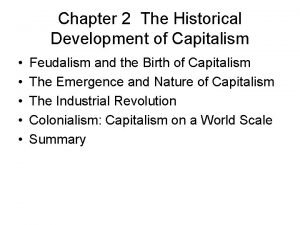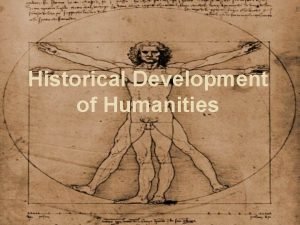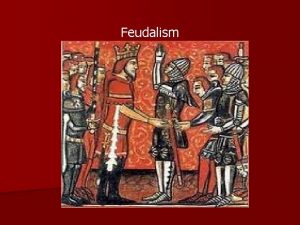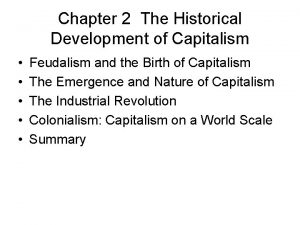Chapter 2 The Historical Development of Capitalism Feudalism
















- Slides: 16

Chapter 2 The Historical Development of Capitalism • • • Feudalism and the Birth of Capitalism The Emergence and Nature of Capitalism The Industrial Revolution Colonialism: Capitalism on a World Scale Summary

The Importance of Historical Processes • The present economic landscape can only be understood as the result of an historical process • Decisions to site production facilities “yesterday” produce the spatial pattern that is the foundation for trade and patterns of consumption today • We can visualize these processes at various geographic scales

Feudalism and the Birth of Capitalism • From hunting & gathering to domesticated agriculture (animals and crops) • Slave-based empires (e. g. Roman) and their feudal successors (ca. 5 th Century) • A form of economic and social relations that extended in Europe to ca. 15 th century • Settlement in North America did not succeed feudalism, but was capitalist in character from the outset

Characteristics of Feudalism • Tradition shaped life and work • In Europe the church was the dominant political and ideological institution • Aristocratic land-owners formed the ruling class, who extracted rents from tenant farmers (often serfs) in low productivity agriculture • Feudal cities – often fortified – with guilds – markets, where universities were established • A hierarchy of feudal towns, mostly small trading centers, with negligible interregional trade

Feudal Regions & The Beginnings of Trade Agricultural innovations; bubonic plague; the European Renaissance

Characteristics of Early Capitalism • Markets: buyers and sellers of goods & services at agreed upon prices • Market types: perfect competition – perfect monopoly – oligopoly (and other types) • The profit incentive = revenue – cost • Dynamic behavior of buyers and sellers, including incentives from innovation in products and production processes • Class relations: merchants & burghers vs. the old aristocracy. “Unlike feudal Europe, workers under capitalism must sell their labor power to survive. Thus the process of commodification extended to include the capacity to labor. ”

The Emergence and Nature of Capitalism • Rise of trade-based city states – links to old trade routes to the Far East and in Europe

Alternative Models of Competition Barriers to Entry - High Barriers to Entry - Low

Attributes of Alternative Market Types “Pure” Monopoly

Early Capitalism, Continued • Finance: replacing barter with money, and institutions to handle and regulate money • Uneven development as an inevitable outcome, historically persistent, at scales ranging from local to global • Long-distance trade – fueled by transport innovation – allowing regional specialization based on principle of comparative advantage • Ideological change – printing/reading, religion, science, the Enlightenment – “a worldview that stressed secularism, individualism, rationality, progress, and democracy. ”

Early Capitalism, Continued • Feudal empires (e. g. Holy Roman Empire, Figure 2. 11) with multiple nation-states • Replaced feudal monarchies with nation-states • Nation states supporting development of capitalism through regulations, public investment and programs (e. g. education, defense, trade protectionism… • BUT: these institutions do not preclude transnational capitalist development, evident in this era of globalization

The Industrial Revolution • Industrialization as a process with multiple transformations in inputs, output, and technologies. Driven by: – Harnessing inanimate sources of energy (Figure 2. 12), wood-coal-petroleum & gas – Technological innovation (Table 2. 1) – Rising Productivity (Figure 2. 14) • Spatial diffusion of the Industrial Revolution

Spread of the Industrial Revolution

Global Diffusion of the Industrial Revolution

Cycles of Industrialization – Kondratiev Long Waves The Fifth Wave – IT & producer Services

Consequences of the Industrial Revolution • Creation of an Industrial Working Class – Rise of organized labor • Urbanization – industry as “city forming” activity • Population Effects: Malthus’ warning vs. productivity increases, health improvements, lowered birth rates • Growth of Global Markets & International Trade – transport improvement, international finance, timing of development
 Feudalism vs capitalism
Feudalism vs capitalism Socialism capitalism hybrid
Socialism capitalism hybrid Feudalism vs communism
Feudalism vs communism History in community
History in community Feudal hierarchy titles
Feudal hierarchy titles Free enterprise lesson
Free enterprise lesson Chapter 13 section 2 feudalism in europe
Chapter 13 section 2 feudalism in europe The decline of feudalism chapter 5 answer key
The decline of feudalism chapter 5 answer key Feudalism in europe chapter 13 section 2
Feudalism in europe chapter 13 section 2 Historical basis of curriculum
Historical basis of curriculum Historical development of community health nursing
Historical development of community health nursing History of the hospitality industry
History of the hospitality industry Historical development of environmental law
Historical development of environmental law History of environmental education
History of environmental education History of technology ppt
History of technology ppt Ancient oriental countries
Ancient oriental countries Historical background of humanities
Historical background of humanities































